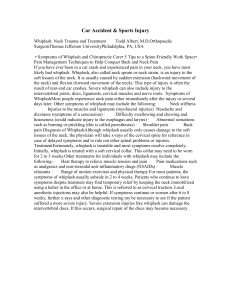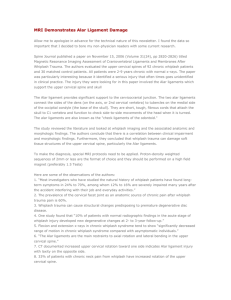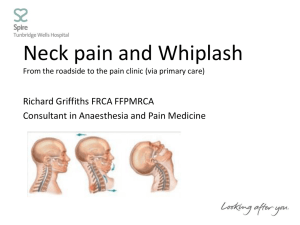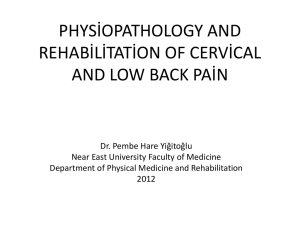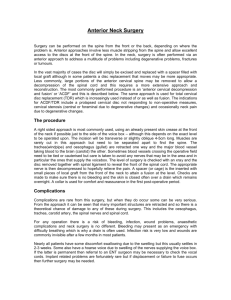Clinical Whiplash & Neck Pain Course References
advertisement
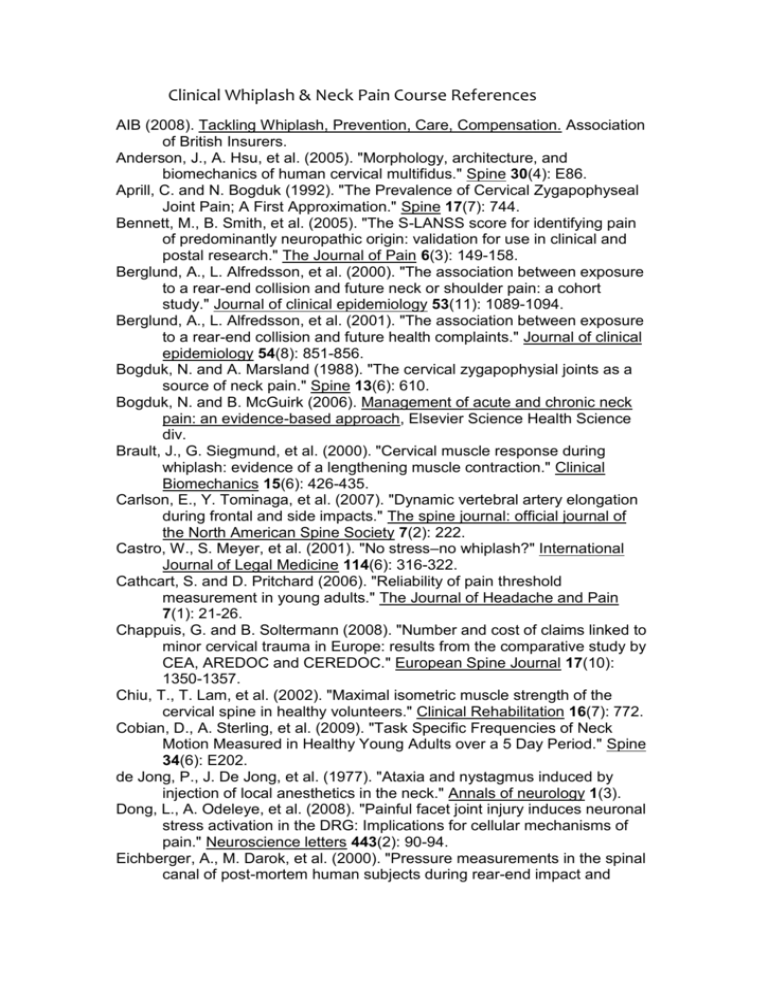
Clinical Whiplash & Neck Pain Course References AIB (2008). Tackling Whiplash, Prevention, Care, Compensation. Association of British Insurers. Anderson, J., A. Hsu, et al. (2005). "Morphology, architecture, and biomechanics of human cervical multifidus." Spine 30(4): E86. Aprill, C. and N. Bogduk (1992). "The Prevalence of Cervical Zygapophyseal Joint Pain; A First Approximation." Spine 17(7): 744. Bennett, M., B. Smith, et al. (2005). "The S-LANSS score for identifying pain of predominantly neuropathic origin: validation for use in clinical and postal research." The Journal of Pain 6(3): 149-158. Berglund, A., L. Alfredsson, et al. (2000). "The association between exposure to a rear-end collision and future neck or shoulder pain: a cohort study." Journal of clinical epidemiology 53(11): 1089-1094. Berglund, A., L. Alfredsson, et al. (2001). "The association between exposure to a rear-end collision and future health complaints." Journal of clinical epidemiology 54(8): 851-856. Bogduk, N. and A. Marsland (1988). "The cervical zygapophysial joints as a source of neck pain." Spine 13(6): 610. Bogduk, N. and B. McGuirk (2006). Management of acute and chronic neck pain: an evidence-based approach, Elsevier Science Health Science div. Brault, J., G. Siegmund, et al. (2000). "Cervical muscle response during whiplash: evidence of a lengthening muscle contraction." Clinical Biomechanics 15(6): 426-435. Carlson, E., Y. Tominaga, et al. (2007). "Dynamic vertebral artery elongation during frontal and side impacts." The spine journal: official journal of the North American Spine Society 7(2): 222. Castro, W., S. Meyer, et al. (2001). "No stress–no whiplash?" International Journal of Legal Medicine 114(6): 316-322. Cathcart, S. and D. Pritchard (2006). "Reliability of pain threshold measurement in young adults." The Journal of Headache and Pain 7(1): 21-26. Chappuis, G. and B. Soltermann (2008). "Number and cost of claims linked to minor cervical trauma in Europe: results from the comparative study by CEA, AREDOC and CEREDOC." European Spine Journal 17(10): 1350-1357. Chiu, T., T. Lam, et al. (2002). "Maximal isometric muscle strength of the cervical spine in healthy volunteers." Clinical Rehabilitation 16(7): 772. Cobian, D., A. Sterling, et al. (2009). "Task Specific Frequencies of Neck Motion Measured in Healthy Young Adults over a 5 Day Period." Spine 34(6): E202. de Jong, P., J. De Jong, et al. (1977). "Ataxia and nystagmus induced by injection of local anesthetics in the neck." Annals of neurology 1(3). Dong, L., A. Odeleye, et al. (2008). "Painful facet joint injury induces neuronal stress activation in the DRG: Implications for cellular mechanisms of pain." Neuroscience letters 443(2): 90-94. Eichberger, A., M. Darok, et al. (2000). "Pressure measurements in the spinal canal of post-mortem human subjects during rear-end impact and correlation of results to the neck injury criterion." Accident Analysis & Prevention 32(2): 251-260. Elliott, J., G. Jull, et al. (2008). "MRI study of the cross-sectional area for the cervical extensor musculature in patients with persistent whiplash associated disorders (WAD)." Manual Therapy 13(3): 258-265. Elliott, J., M. Sterling, et al. (2008). "Fatty infiltrate in the cervical extensor muscles is not a feature of chronic, insidious-onset neck pain." Clinical radiology 63(6): 681-687. Elliott, J., M. Sterling, et al. (2009). "The clinical presentation of chronic whiplash and the relationship to findings of MRI fatty infiltrates in the cervical extensor musculature: a preliminary investigation." European Spine Journal 18(9): 1371-1378. Elliott, J., S. O'Leary, et al. (2010). "Magnetic Resonance Imaging Findings of Fatty Infiltrate in the Cervical Flexors in Chronic Whiplash." Spine 35(9): 948. Falla, D., A. Rainoldi, et al. (2003). "Myoelectric manifestations of sternocleidomastoid and anterior scalene muscle fatigue in chronic neck pain patients." Clinical Neurophysiology 114(3): 488-495. Falla, D., G. Jull, et al. (2003). "An electromyographic analysis of the deep cervical flexor muscles in performance of craniocervical flexion." Physical Therapy 83(10): 899. Falla, D., G. Bilenkij, et al. (2004). "Patients with chronic neck pain demonstrate altered patterns of muscle activation during performance of a functional upper limb task." Spine 29(13): 1436. Falla, D., G. Jull, et al. (2004). "Neuromuscular efficiency of the sternocleidomastoid and anterior scalene muscles in patients with chronic neck pain." Disability & Rehabilitation 26(12): 712-717. Falla, D., G. Jull, et al. (2004). "Feedforward activity of the cervical flexor muscles during voluntary arm movements is delayed in chronic neck pain." Experimental Brain Research 157(1): 43-48. Falla, D., G. Jull, et al. (2004). "Patients with neck pain demonstrate reduced electromyographic activity of the deep cervical flexor muscles during performance of the craniocervical flexion test." Spine 29(19): 2108. Falla, D., G. Jull, et al. (2004). "Neck flexor muscle fatigue is side specific in patients with unilateral neck pain." European Journal of Pain 8(1): 7177. Falla, D., G. Jull, et al. (2006). "An endurance-strength training regime is effective in reducing myoelectric manifestations of cervical flexor muscle fatigue in females with chronic neck pain." Clinical Neurophysiology 117(4): 828-837. Falla, D., G. Jull, et al. (2007). "Effect of neck exercise on sitting posture in patients with chronic neck pain." Physical Therapy 87(4): 408. Feipel, V., P. Salvia, et al. (2006). "Head repositioning accuracy in patients with whiplash-associated disorders." Spine 31(2): E51. Ferrari, R. (2005). The whiplash encyclopedia: the facts and myths of whiplash, Jones & Bartlett Pub. Field, S., J. Treleaven, et al. (2008). "Standing balance: a comparison between idiopathic and whiplash-induced neck pain." Manual Therapy 13(3): 183-191. Fischer, A. (1987). "Pressure algometry over normal muscles. Standard values, validity and reproducibility of pressure threshold." Pain 30(1): 115-126. Goldscheider, A. (1889). "Untersuchungen über den Muskelsinn." Arch Anat Physiol 3: 369-502. Gonzalez-Iglesias, J., C. Fernandez-De-Las-Penas, et al. (2009). "Short-Term Effects of Cervical Kinesio Taping on Pain and Cervical Range of Motion in Patients With Acute Whiplash Injury: A Randomized Clinical Trial." The Journal of orthopaedic and sports physical therapy 39(7): 515-521. Gosselin, G., H. Rassoulian, et al. (2004). "Effects of neck extensor muscles fatigue on balance." Clinical Biomechanics 19(5): 473-479. Heikkila, H. and P. G. Astrom (1996). "Cervicocephalic kinesthetic sensibility in patients with whiplash injury." Scandinavian Journal of Rehabilitation Medicine 28(3): 133-138. Heikkila, H., M. Johansson, et al. (2000). "Effects of acupuncture, cervical manipulation and NSAID therapy on dizziness and impaired head repositioning of suspected cervical origin: a pilot study." Manual Therapy 5(3): 151-157. Heikkila, H. V. and B. I. Wenngren (1998). "Cervicocephalic kinesthetic sensibility, active range of cervical motion, and oculomotor function in patients with whiplash injury." Archives of Physical Medicine & Rehabilitation 79(9): 1089-1094. Hildingsson, C., B. I. Wenngren, et al. (1989). "Oculomotor problems after cervical spine injury." Acta Orthopaedica Scandinavica 60(5): 513-516. Hildingsson, C., B. I. Wenngren, et al. (1993). "Eye motility dysfunction after soft-tissue injury of the cervical spine. A controlled, prospective study of 38 patients." Acta Orthopaedica Scandinavica 64(2): 129-132. Horowitz, M., N. Wilner, et al. (1979). "Impact of event scale." Psychosomatic Medicine 41: 209-218. Howe J.F. Loeser et al (1977) “Mechanosensitivity of dorsal root ganglia and chronically injured axons: a physiological basis for the radicular pain of nerve root compression.” Pain 3 (1): 25-41. Humphreys, B., J. Bolton, et al. (2002). "A cross-sectional study of the association between pain and disability in neck pain patients with dizziness of suspected cervical origin." Journal of Whiplash & Related Disorders 1(2): 63-73. Humphreys, B. and P. Irgens (2002). "The effect of a rehabilitation exercise program on head repositioning accuracy and reported levels of pain in chronic neck pain subjects." Journal of Whiplash & Related Disorders 1(1): 99-112. Ivancic, P., S. Ito, et al. (2006). "Effect of rotated head posture on dynamic vertebral artery elongation during simulated rear impact." Clinical Biomechanics 21(3): 213-220. Ivancic, P., S. Ito, et al. (2008). "Whiplash causes increased laxity of cervical capsular ligament." Clinical Biomechanics 23(2): 159-165. Jensen, M., P. Karoly, et al. (1986). "The measurement of clinical pain intensity: a comparison of six methods." Pain 27(1): 117-126. Jordan, A., J. Mehlsen, et al. (1999). "Maximal isometric strength of the cervical musculature in 100 healthy volunteers." Spine 24(13): 1343. Jull, G. (2000). "Deep cervical flexor muscle dysfunction in whiplash." Journal of Musculoskelatal Pain 8(1-2): 143-154. Jull, G., E. Kristjansson, et al. (2004). "Impairment in the cervical flexors: a comparison of whiplash and insidious onset neck pain patients." Manual Therapy 9(2): 89-94. Jull, G., D. Falla, et al. (2007). "Retraining cervical joint position sense: The effect of two exercise regimes." Journal of Orthopaedic Research 25(3): 404-412. Jull, G., M. Sterling, et al. (2007). "Does the presence of sensory hypersensitivity influence outcomes of physical rehabilitation for chronic whiplash?-A preliminary RCT." Pain 129(1-2): 28-34. Jull, G., S. O'Leary, et al. (2008a). "Clinical assessment of the deep cervical flexor muscles: the craniocervical flexion test." Journal of Manipulative and Physiological Therapeutics 31(7): 525-533. Jull, G., M. Sterling, et al. (2008b). Whiplash, headache, and neck pain: research-based directions for physical therapies, Elsevier Health Sciences. Jull, G., D. Falla, et al. (2009). "The effect of therapeutic exercise on activation of the deep cervical flexor muscles in people with chronic neck pain." Manual Therapy 14(6): 696-701. Kaale, B., J. Krakenes, et al. (2005a). "Head position and impact direction in whiplash injuries: associations with MRI-verified lesions of ligaments and membranes in the upper cervical spine." Journal of Neurotrauma 22(11): 1294-1302. Kaale, B., J. Krakenes, et al. (2005b). "Whiplash-associated disorders impairment rating: neck disability index score according to severity of MRI findings of ligaments and membranes in the upper cervical spine." Journal of Neurotrauma 22(4): 466-475. Kaale, B., J. Krakenes, et al. (2007). "Active range of motion as an indicator for ligament and membrane lesions in the upper cervical spine after a whiplash trauma." Journal of Neurotrauma 24(4): 713-721. Kaale, B., J. Krakenes, et al. (2008). "Clinical assessment techniques for detecting ligament and membrane injuries in the upper cervical spine region--A comparison with MRI results." Manual Therapy 13(5): 397403. Kamibayashi, L. and F. Richmond (1998). "Morphometry of human neck muscles." Spine 23(12): 1314. Karlberg, M. and M. Magnusson (1996). "Postural and symptomatic improvement after physiotherapy in patients with dizziness of suspected cervical origin* 1." Archives of physical medicine and rehabilitation 77(9): 874-882. Krakenes, J., B. Kaale, et al. (2002). "MRI assessment of the alar ligaments in the late stage of whiplash injury-a study of structural abnormalities and observer agreement." Neuroradiology 44(7): 617-624. Krakenes, J., B. Kaale, et al. (2003). "MR analysis of the transverse ligament in the late stage of whiplash injury." Acta Radiologica 44(6): 637-644. Lee, K., J. Thinnes, et al. (2004). "A novel rodent neck pain model of facetmediated behavioral hypersensitivity: implications for persistent pain and whiplash injury." Journal of neuroscience methods 137(2): 151159. Lee, K., M. Davis, et al. (2008). "Capsular Ligament Involvement in the Development of Mechanical Hyperalgesia after Facet Joint Loading: Behavioral and Inflammatory Outcomes in a Rodent Model of Pain." Journal of Neurotrauma 25(11): 1383-1393. Lees-Haley, P. and R. Brown (1993). "Neuropsychological complaint base rates of 170 personal injury claimants." Archives of Clinical Neuropsychology 8(3): 203-209. Lees-Haley, P., J. Price, et al. (2001). "Use of the impact of events scale in the assessment of emotional distress and PTSD may produce misleading results." Journal of Forensic Neuropsychology 2(2): 45-52. Loudon, J. K., M. Ruhl, et al. (1997). "Ability to reproduce head position after whiplash injury." Spine 22(8): 865-868. Malleson, A. (2002). Whiplash and other useful injuries, Quebec, Canada McGill-Queen’s University Press. Malmstrom, E.-M., M. Karlberg, et al. (2007). "Cervicogenic dizziness musculoskeletal findings before and after treatment and long-term outcome." Disability & Rehabilitation 29(15): 1193-1205. McCully, K. and J. Faulkner (1985). "Injury to skeletal muscle fibers of mice following lengthening contractions." Journal of Applied Physiology 59(1): 119. O'Leary, S., D. Falla, et al. (2007). "Muscle specificity in tests of cervical flexor muscle performance." Journal of Electromyography and Kinesiology 17(1): 35-40. O'Leary, S., G. Jull, et al. (2007). "Cranio-cervical flexor muscle impairment at maximal, moderate, and low loads is a feature of neck pain." Manual Therapy 12(1): 34-39. Ortengren, T., H. A. Hansson, et al. (1996). "Membrane leakage in spinal ganglion nerve cells induced by experimental whiplash extension motion: a study in pigs." Journal of Neurotrauma 13(3): 171-180. Palmgren, P., A. Lindeberg, et al. (2009). "Head Repositioning Accuracy and Posturography Related to Cervical Facet Nerve Blockade and Spinal Manipulative Therapy in Healthy Volunteers: A Time Series Study." Journal of Manipulative and Physiological Therapeutics 32(3): 193-202. Peck, D., D. Buxton, et al. (1984). "A comparison of spindle concentrations in large and small muscles acting in parallel combinations." Journal of Morphology 180(3). Pinsault, N., A. Fleury, et al. (2007). "Test-retest reliability of cervicocephalic relocation test to neutral head position." Physiotherapy Theory and Practice 24(5): 380-391. Pinsault, N., N. Vuillerme, et al. (2008). "Cervicocephalic relocation test to the neutral head position: assessment in bilateral labyrinthine-defective and chronic, nontraumatic neck pain patients." Archives of physical medicine and rehabilitation 89(12): 2375-2378. Pinsault, N. and N. Vuillerme (2009). "The Effect of Free Fly Expertise on Cervical Joint Position Sense: A Pilot Study." Research in Sports Medicine 17(1): 28-34. Pinsault, N. and N. Vuillerme (2010). "Degradation of Cervical Joint Position Sense Following Muscular Fatigue in Humans." Spine 35(3): 294. Provinciali, L., M. Baroni, et al. (1996). "Multimodal treatment to prevent the late whiplash syndrome." Scandinavian Journal of Rehabilitation Medicine 28(2): 105. Prushansky, T., R. Gepstein, et al. (2005). "Cervical muscles weakness in chronic whiplash patients." Clinical Biomechanics 20(8): 794-798. Pyykkö, I., H. Aalto, et al. (1989). "Hierarchy of different muscles in postural control." Acta Oto-Laryngologica 108(S468): 175-180. Quinn, K., L. Dong, et al. (2010). "Neuronal hyperexcitability in the dorsal horn after painful facet joint injury." Pain. Quinn, K. and B. Winkelstein (2007). "Cervical facet capsular ligament yield defines the threshold for injury and persistent joint-mediated neck pain." Journal of biomechanics 40(10): 2299-2306. Revel, M., C. Andre-Deshays, et al. (1991). "Cervicocephalic kinesthetic sensibility in patients with cervical pain." Archives of Physical Medicine & Rehabilitation 72(5): 288-291. Revel, M., M. Minguet, et al. (1994). "Changes in cervicocephalic kinesthesia after a proprioceptive rehabilitation program in patients with neck pain: a randomized controlled study." Archives of physical medicine and rehabilitation 75(8): 895-899. Richmond, F. and D. Bakker (1982). "Anatomical organization and sensory receptor content of soft tissues surrounding upper cervical vertebrae in the cat." Journal of neurophysiology 48(1): 49-61. Rosenfeld, M., R. Gunnarsson, et al. (2000). "Early intervention in whiplashassociated disorders: a comparison of two treatment protocols." Spine 25(14): 1782. Rosenfeld, M., A. Seferiadis, et al. (2003). "Active intervention in patients with whiplash-associated disorders improves long-term prognosis: a randomized controlled clinical trial." Spine 28(22): 2491. Schieppati, M., A. Nardone, et al. (2003). "Neck muscle fatigue affects postural control in man." Neuroscience 121(2): 277-285. Schrader, H., G. Bovim, et al. (1996). "Natural evolution of late whiplash syndrome outside the medicolegal context." The Lancet 347(9010): 1207-1211. Scott, S. and P. Sanderson (2002). "Whiplash: a biochemical study of muscle injury." European Spine Journal 11(4): 389-392. Sherrington, S. (1906). The integrative action of the nervous system. New Haven, Yale University Press. Siegmund, G., B. Winkelstein, et al. (2009). "The Anatomy and Biomechanics of Acute and Chronic Whiplash Injury." Traffic Injury Prevention 10(2): 101-112. Spearing, N. and L. Connelly (2010). "Is compensation" bad for health"? A systematic meta-review." Injury. Stapley, P. J., M. V. Beretta, et al. (2006). "Neck muscle fatigue and postural control in patients with whiplash injury." Clinical Neurophysiology 117(3): 610-622. Stemper, B., N. Yoganandan, et al. (2006). "Anterior longitudinal ligament injuries in whiplash may lead to cervical instability." Medical engineering & physics 28(6): 515-524. Sterling, M., J. Treleaven, et al. (2002). "Responses to a clinical test of mechanical provocation of nerve tissue in whiplash associated disorder* 1." Manual Therapy 7(2): 89-94. Sterling, M., G. Jull, et al. (2003a). "Sensory hypersensitivity occurs soon after whiplash injury and is associated with poor recovery." Pain 104(3): 509-517. Sterling, M., G. Jull, et al. (2003b). "Development of motor system dysfunction following whiplash injury." Pain 103(1-2): 65-73. Sterling, M., J. Kenardy, et al. (2003c). "The development of psychological changes following whiplash injury." Pain 106(3): 481-489. Sterling, M., G. Jull, et al. (2005). "Physical and psychological factors predict outcome following whiplash injury." Pain 114(1-2): 141-148. Sterling, M., G. Jull, et al. (2006). "Physical and psychological factors maintain long-term predictive capacity post-whiplash injury." Pain 122(1-2): 102108. Sterling, M. (2008a). "Testing for sensory hypersensitivity or central hyperexcitability associated with cervical spine pain." Journal of Manipulative and Physiological Therapeutics 31(7): 534-539. Sterling, M. and J. Kenardy (2008b). "Physical and psychological aspects of whiplash: Important considerations for primary care assessment." Manual Therapy 13(2): 93-102. Sterling, M. (2009). "Physical and psychological aspects of whiplash: Important considerations for primary care assessment, Part 2–Case studies." Manual Therapy 14(1): 8-12. Sterling, M. and A. Pedler (2009). "A neuropathic pain component is common in acute whiplash and associated with a more complex clinical presentation." Manual Therapy 14(2): 173-179. Sterling, M., A. Pedler, et al. (2009). "Cervical lateral glide increases nociceptive flexion reflex threshold but not pressure or thermal pain thresholds in chronic whiplash associated disorders: A pilot randomised controlled trial." Manual Therapy. Sterling, M., S. Valentin, et al. (2009). "Dry needling and exercise for chronic whiplash-a randomised controlled trial." BMC Musculoskeletal Disorders 10(1): 160. Sterling, M., J. Hendrikz, et al. (2010). "Compensation claim lodgement and health outcome developmental trajectories following whiplash injury: A prospective study." Pain. Stewart, M., C. Maher, et al. (2007). "Randomized controlled trial of exercise for chronic whiplash-associated disorders." Pain 128(1-2): 59-68. Svensson, M., O. Boström, et al. (2000). "Neck injuries in car collisions--a review covering a possible injury mechanism and the development of a new rear-impact dummy." Accident Analysis & Prevention 32(2): 167175. Svensson, M. Y., B. Aldman, et al. (1998). "Transient pressure gradients in the pig spinal canal during experimental whiplash motion causing membrane dysfunction in spinal ganglion nerve cells. [German]." Orthopade 27(12): 820-826. Tjell, C. and U. Rosenhall (1998). "Smooth pursuit neck torsion test: a specific test for cervical dizziness." Otology & Neurotology 19(1): 76. Treleaven, J., G. Jull, et al. (2003). "Dizziness and unsteadiness following whiplash injury: characteristic features and relationship with cervical joint position error." Journal of Rehabilitation Medicine 35(1): 36-43. Treleaven, J., G. Jull, et al. (2005). "Smooth pursuit neck torsion test in whiplash-associated disorders: relationship to self-reports of neck pain and disability, dizziness and anxiety." Journal of Rehabilitation Medicine 37(4): 219-223. Treleaven, J., G. Jull, et al. (2005). "Standing balance in persistent whiplash: a comparison between subjects with and without dizziness." Journal of Rehabilitation Medicine 37(4): 224-229. Treleaven, J., G. Jull, et al. (2006). "The relationship of cervical joint position error to balance and eye movement disturbances in persistent whiplash." Manual Therapy 11(2): 99-106. Treleaven, J., N. LowChoy, et al. (2008). "Comparison of sensorimotor disturbance between subjects with persistent whiplash-associated disorder and subjects with vestibular pathology associated with acoustic neuroma." Archives of Physical Medicine & Rehabilitation 89(3): 522-530. Uhlig, Y., B. Weber, et al. (1995). "Fiber composition and fiber transformations in neck muscles of patients with dysfunction of the cervical spine." Journal of Orthopaedic Research 13(2): 240-249. Vernon, H., P. Aker, et al. (1992). "Evaluation of neck muscle strength with a modified sphygmomanometer dynamometer: reliability and validity." J Manipulative Physiol Ther 15(6): 343-349. Vernon, H. and S. Mior (1991). "The Neck Disability Index: a study of reliability and validity." Journal of Manipulative and Physiological Therapeutics 14(7): 409. Vetti, N., J. Kråkenes, et al. (2009). "MRI of the alar and transverse ligaments in whiplash-associated disorders (WAD) grades 1–2: high-signal changes by age, gender, event and time since trauma." Neuroradiology 51(4): 227-235. Vuillerme, N., N. Pinsault, et al. (2005). "Postural control during quiet standing following cervical muscular fatigue: effects of changes in sensory inputs." Neuroscience letters 378(3): 135-139. Vuillerme, N. and N. Pinsault (2009). "Experimental neck muscle pain impairs standing balance in humans." Experimental Brain Research 192(4): 723-729. Vuillerme, N., N. Pinsault, et al. (2008). "Cervical joint position sense is impaired in older adults." Aging Clin Exp Res 20(4). Wallis, B., S. Lord, et al. (1997). "Resolution of psychological distress of whiplash patients following treatment by radiofrequency neurotomy: a randomised, double-blind, placebo-controlled trial." Pain 73(1): 15-22. Williams, M., E. Williamson, et al. (2007). "A systematic literature review of physical prognostic factors for the development of late whiplash syndrome." Spine 32(25): E764. Williamson, E., M. Williams, et al. (2008). "A systematic literature review of psychological factors and the development of late whiplash syndrome." Pain 135(1-2): 20-30. Ylinen, J., M. Nykänen, et al. (2007). "Evaluation of repeatability of pressure algometry on the neck muscles for clinical use." Manual Therapy 12(2): 192-197. Ylinen, J. and J. Ruuska (1994). "Clinical use of neck isometric strength measurement in rehabilitation." Archives of physical medicine and rehabilitation 75(4): 465. Ylinen, J., P. Salo, et al. (2004). "Decreased isometric neck strength in women with chronic neck pain and the repeatability of neck strength measurements." Archives of physical medicine and rehabilitation 85(8): 1303-1308. Ylinen, J., E. Takala, et al. (2005). "Effect of long-term neck muscle training on pressure pain threshold: a randomized controlled trial." European journal of pain (London, England) 9(6): 673. Ylinen, J., E. Takala, et al. (2003). "Active neck muscle training in the treatment of chronic neck pain in women: a randomized controlled trial." Jama 289(19): 2509. Yoganandan, N. and F. Pintar (2000). Frontiers in whiplash trauma: clinical and biomechanical, Ios Pr Inc.
